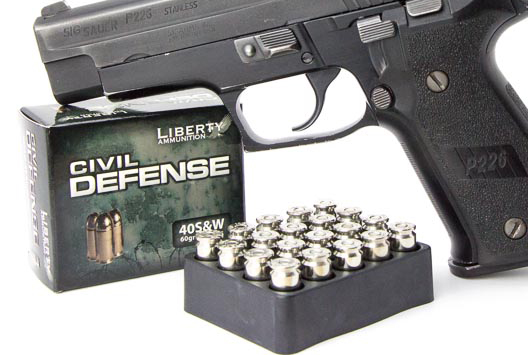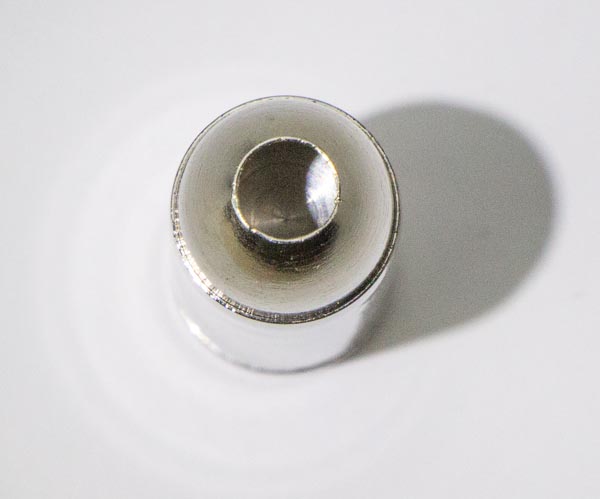 (Ed. note: Richard of BlueSheepdog.com and GunsHolstersandGear.com was kind enough to review this ammunition for me. He is a true gentleman, experienced law enforcement officer and writer, and a really bad joke teller.)
(Ed. note: Richard of BlueSheepdog.com and GunsHolstersandGear.com was kind enough to review this ammunition for me. He is a true gentleman, experienced law enforcement officer and writer, and a really bad joke teller.)
Knocking someone through a plate glass window with a single shot from a pistol is the stuff of TV fantasy. Handgun ammo is just not that powerful. In fact, pistol calibers are generally considered marginal for stopping a violent attacker when compared to rifle and shotgun loads.
Even so, there are definitely differences between handgun ammunition designs that can affect how quickly an attacker is stopped when shot. Some rounds have built reputations as being effective on the street, while others have been dubbed “widow makers” because of the poor results experienced by the officers relying on them.
Liberty Ammunition is a Florida company building unconventional ammunition for self-defense. The company’s Civil Defense line of handgun ammo uses a variety of techniques to create significant wound channels that are likely to quickly incapacitate an attacker.
Generally, Liberty Ammunition uses lighter-than-typical bullet weights in each caliber. This allows the bullets to be driven to much higher velocities while still staying within the pressure specifications set out by the Sporting Arms and Ammunition Manufacturers’ Institute (SAAMI.)
Energy can be described as the potential amount of work done. Since the energy is measured as the mass times the square of the velocity, dropping the bullet weight while increasing the speed can actually produce a load that has more energy than a conventional load design. The idea is the more energy a bullet has, the more work – or damage – it can do to the attacker.
The Civil Defense line of ammunition uses solid copper hollowpoint bullets that are nickel plated. Nickel has very good lubricity, meaning that it slides through a gun barrel easier that copper. Less velocity is lost due to friction in the barrel and that translates to both a faster bullet velocity and less barrel fouling.
At the Range
Randall provided me with several boxes of .380 ACP and .40 S&W Civil Defense ammo for testing. As is my normal M.O., I am happy to shoot someone else’s ammunition.
I shot the .380 ACP ammo through two guns: a Smith & Wesson M&P Bodyguard 380 and the Glock 42. I then shot the .40 S&W loads through a SIG SAUER P226 and a Glock 22. All four guns shot the ammo with no problems. All of the pistols functioned with 100% reliability. The velocity measurements were quite interesting. Both loads came in under the advertised velocities, but were still significantly faster than anything else I have shot in these calibers. I measured the velocities with a Competition Electronics ProChrono digital chronograph set up at 15’ from the muzzle. I should note that Liberty Ammunition is a member company of SAAMI. All of its ammunition meets SAAMI specs.
The velocity measurements were quite interesting. Both loads came in under the advertised velocities, but were still significantly faster than anything else I have shot in these calibers. I measured the velocities with a Competition Electronics ProChrono digital chronograph set up at 15’ from the muzzle. I should note that Liberty Ammunition is a member company of SAAMI. All of its ammunition meets SAAMI specs.
From the Bodyguard, the .380 ACP averaged 1319 fps across the chronograph. Out of the Glock 42, the velocity was a bit faster at 1354 fps. Breaking out the calculator, the load produced 193 ft-lbs and 203 ft-lbs of energy respectively. The manufacturer rates this load at 1500 fps from a test barrel.
The .40 S&W load averaged 1989 fps out of the Glock 22. From the SIG P226, the velocity was slightly less at 1978 fps. This works out to be 527 ft-lbs and 521 ft-lbs of energy respectively. These velocities come very close to the stated velocity of 2000 fps.
Even though the velocities were much higher than one would normally achieve in these calibers, the felt recoil did not seem to be any more than other ammunition. In .40 S&W, the recoil actually felt less than other self-defense ammo.
Penetration Concerns
One of the concerns that people bring up with ammo that uses light bullets driven to high velocities is adequate penetration. For law enforcement use, there are generally three areas of concern regarding penetration:
1. Will the bullet penetrate to an adequate depth in the body to reach vital organs?
2. Will the bullet penetrate intermediate barriers and clothing yet still perform in flesh?
3. Will the bullet over-penetrate and possibly injure or kill another officer or bystander?
The Civil Defense ammo uses bullets with very deep hollowpoints. When striking flesh, these bullets rapidly expand creating a large wound channel. The petals of the hollowpoint tend to shear off and form their own wound tracks, causing further exsanguination.

 However, the central part of the bullet continues to penetrate deeper into the body – typically to a distance of 12” – 14” in ballistic gelatin. A penetration depth of 12” in ballistic gelatin is the arbitrary minimum distance the FBI determined was suitable for the needs of its agents.
However, the central part of the bullet continues to penetrate deeper into the body – typically to a distance of 12” – 14” in ballistic gelatin. A penetration depth of 12” in ballistic gelatin is the arbitrary minimum distance the FBI determined was suitable for the needs of its agents.
I had a chance to see a demonstration of the 9mm Civil Defense ammunition at the Make Big Noise event this summer. Shooting the temperature stable Clear Ballistics gelatin, the 9mm rounds consistently penetrated beyond 12”, and never exited the 16” blocks. This included shooting through t-shirts, towels and other clothing material that participants wanted to shoot.
At the same event, we shot through car doors and windshields. The 9mm round punched through one car door, entered the passenger compartment and embedded itself in the opposite door. Another company’s self-defense round failed to completely penetrate the first car door.
Shooting the ammo from the inside of the car through the windshield, the rounds penetrated and struck point of aim on a target at about 15’. Shooting through the windshield from the outside of the car, the ammo again penetrated, but with a very slight rise from the point of aim. Typically, one would expect the bullet to deflect down, and by a larger distance than we saw with the rise in the Civil Defense bullet.
While I would want to do more extensive testing on barriers and gelatin before switching a department to this ammo, I will say I was impressed by the initial results. The round appeared to penetrate to the FBI minimum without over-penetrating. Additionally, the light round seemed to punch through sheet metal and laminated glass – two of the toughest barriers – without any problem.
Although it is not terribly scientific, we also got to see a few hams shot at the same event. The damage done by the Civil Defense ammo was significantly more than that done by a another company’s self-defense load.
Final Thoughts
The Civil Defense ammo is a very interesting line of self-defense ammunition. It seems to offer a lot of the things that people want such as reliability, penetration and massive wounding. In addition to .380 ACP and .40 S&W, the company offers Civil Defense ammo in 9mm, .38 Special, .357 Magnum and .45 ACP.
Richard


Pingback: Liberty Ammunition Civil Defense Review from ThinBlueFlorida.com | Liberty Ammunition
Pingback: Liberty Ammunition Civil Defense Review: ThinBlueFlorida.com
Pingback: Police mag review of new Liberty Civil Defense ammo...1800-2000 fps!